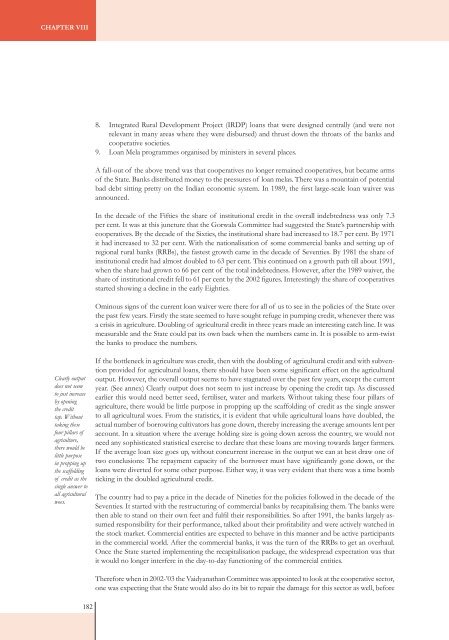SOIL Report 2008 - ACCESS Development Services
SOIL Report 2008 - ACCESS Development Services
SOIL Report 2008 - ACCESS Development Services
Create successful ePaper yourself
Turn your PDF publications into a flip-book with our unique Google optimized e-Paper software.
Chapter VIII8. Integrated Rural <strong>Development</strong> Project (IRDP) loans that were designed centrally (and were notrelevant in many areas where they were disbursed) and thrust down the throats of the banks andcooperative societies.9. Loan Mela programmes organised by ministers in several places.A fall-out of the above trend was that cooperatives no longer remained cooperatives, but became armsof the State. Banks distributed money to the pressures of loan melas. There was a mountain of potentialbad debt sitting pretty on the Indian economic system. In 1989, the first large-scale loan waiver wasannounced.In the decade of the Fifties the share of institutional credit in the overall indebtedness was only 7.3per cent. It was at this juncture that the Gorwala Committee had suggested the State’s partnership withcooperatives. By the decade of the Sixties, the institutional share had increased to 18.7 per cent. By 1971it had increased to 32 per cent. With the nationalisation of some commercial banks and setting up ofregional rural banks (RRBs), the fastest growth came in the decade of Seventies. By 1981 the share ofinstitutional credit had almost doubled to 63 per cent. This continued on a growth path till about 1991,when the share had grown to 66 per cent of the total indebtedness. However, after the 1989 waiver, theshare of institutional credit fell to 61 per cent by the 2002 figures. Interestingly the share of cooperativesstarted showing a decline in the early Eighties.Ominous signs of the current loan waiver were there for all of us to see in the policies of the State overthe past few years. Firstly the state seemed to have sought refuge in pumping credit, whenever there wasa crisis in agriculture. Doubling of agricultural credit in three years made an interesting catch line. It wasmeasurable and the State could pat its own back when the numbers came in. It is possible to arm-twistthe banks to produce the numbers.Clearly outputdoes not seemto just increaseby openingthe credittap. Withouttaking thesefour pillars ofagriculture,there would belittle purposein propping upthe scaffoldingof credit as thesingle answer toall agriculturalwoes.If the bottleneck in agriculture was credit, then with the doubling of agricultural credit and with subventionprovided for agricultural loans, there should have been some significant effect on the agriculturaloutput. However, the overall output seems to have stagnated over the past few years, except the currentyear. (See annex) Clearly output does not seem to just increase by opening the credit tap. As discussedearlier this would need better seed, fertiliser, water and markets. Without taking these four pillars ofagriculture, there would be little purpose in propping up the scaffolding of credit as the single answerto all agricultural woes. From the statistics, it is evident that while agricultural loans have doubled, theactual number of borrowing cultivators has gone down, thereby increasing the average amounts lent peraccount. In a situation where the average holding size is going down across the country, we would notneed any sophisticated statistical exercise to declare that these loans are moving towards larger farmers.If the average loan size goes up, without concurrent increase in the output we can at best draw one oftwo conclusions: The repayment capacity of the borrower must have significantly gone down, or theloans were diverted for some other purpose. Either way, it was very evident that there was a time bombticking in the doubled agricultural credit.The country had to pay a price in the decade of Nineties for the policies followed in the decade of theSeventies. It started with the restructuring of commercial banks by recapitalising them. The banks werethen able to stand on their own feet and fulfil their responsibilities. So after 1991, the banks largely assumedresponsibility for their performance, talked about their profitability and were actively watched inthe stock market. Commercial entities are expected to behave in this manner and be active participantsin the commercial world. After the commercial banks, it was the turn of the RRBs to get an overhaul.Once the State started implementing the recapitalisation package, the widespread expectation was thatit would no longer interfere in the day-to-day functioning of the commercial entities.Therefore when in 2002-’03 the Vaidyanathan Committee was appointed to look at the cooperative sector,one was expecting that the State would also do its bit to repair the damage for this sector as well, before182














